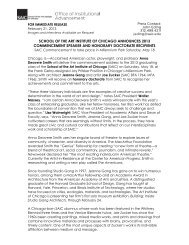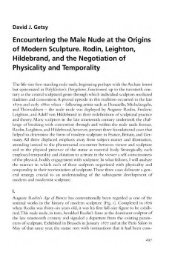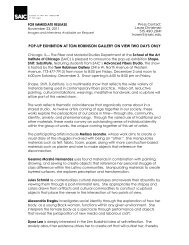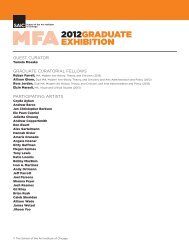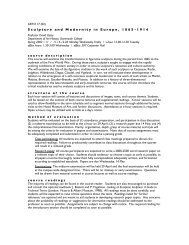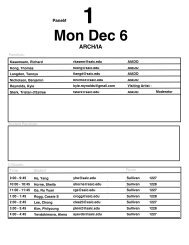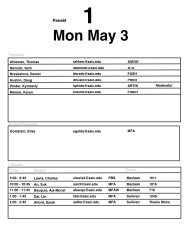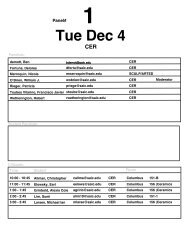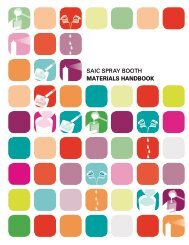i. institutional support and commitment to continuous improvement
i. institutional support and commitment to continuous improvement
i. institutional support and commitment to continuous improvement
Create successful ePaper yourself
Turn your PDF publications into a flip-book with our unique Google optimized e-Paper software.
Course Number & Title:<br />
INARCH 6210 Interior Architecture Studio 5:<br />
Fluid Spaces (4.5)<br />
Course Description:<br />
This comprehensive design studio requires a techni-<br />
cally complete building design, typically a large addi-<br />
tion attached <strong>to</strong> <strong>and</strong> within a larger existing building<br />
with sitework <strong>and</strong> facades. The course uses a variety<br />
of discrete analytical, diagrammatic <strong>and</strong> visualization<br />
exercises <strong>to</strong> register obscure existing conditions <strong>and</strong><br />
cultural changes in<strong>to</strong> clear terms so the designer, client<br />
<strong>and</strong> the public can underst<strong>and</strong> them <strong>and</strong> the new solu-<br />
tions that arise out of them.<br />
Course Goals & Objectives:<br />
1) Design culture: methods of integration <strong>and</strong> in-<br />
formation synthesis in contemporary architectural<br />
design.<br />
2) Design practice: advanced design methods, em-<br />
phasizing feasibility, <strong>and</strong> comprehension through the<br />
design of a large building with an extensive systems<br />
integration challenge.<br />
3) Design practice: Work sensitively with the con-<br />
text of an existing building that is obsolete or incom-<br />
plete for the proposed usage.<br />
4) Design techniques <strong>and</strong> skills: Develop an ad-<br />
vanced level of architectural representation, with an<br />
emphasis on analysis, plans, sections <strong>and</strong> elevations,<br />
<strong>and</strong> model construction.<br />
5) Design techniques <strong>and</strong> skills: Analyze <strong>and</strong> revise a<br />
typical program document <strong>to</strong> suit your ideas for the<br />
project. Analyze the building code <strong>and</strong> zoning require-<br />
ments <strong>and</strong> write yourself a guide that contains all<br />
relevant <strong>and</strong> necessary rules.<br />
6) Design techniques <strong>and</strong> skills: Learn <strong>and</strong> ap-<br />
ply competent rules of thumb for cost estimating,<br />
acoustic design, HVAC systems, building services,<br />
vegetation, <strong>and</strong> exterior drainage.<br />
Student Performance Criterion:<br />
1) Best exemplifies the following criteria:<br />
a) B.6. Comprehensive Design (ability)<br />
b) B.7. Financial Considerations (underst<strong>and</strong>ing)<br />
2) Additional criteria associated with SPC B.6<br />
a) A.2. Design Thinking (ability)<br />
b) A.4 Technical Documentation (ability)<br />
c) A.5. Investigative Skills (ability)<br />
d) A.8. Ordering Systems Skills (underst<strong>and</strong>ing)<br />
e) A.9 His<strong>to</strong>rical Traditions & Global Culture<br />
(underst<strong>and</strong>ing)<br />
f) B.2. Accessibility (ability)<br />
g) B.3. Sustainability (ability)<br />
h) B.4. Site Design (ability)<br />
i) B.5. Life Safety (ability)<br />
j) B.8. Environmental Systems (underst<strong>and</strong>ing)<br />
k) B.9. Structural Systems (underst<strong>and</strong>ing)<br />
l) B.11. Building Service Systems (underst<strong>and</strong>ing)<br />
Topical Outline:<br />
179 | Spring 2011<br />
IV. Supplemental Information<br />
1) Design culture: ‘disciplinary literacy’— student will<br />
examine <strong>and</strong> critique contemporary practice relevant<br />
<strong>to</strong> studio <strong>to</strong>pic; 10% of the course.<br />
2) Design practice: through a series of lectures <strong>and</strong><br />
exercises, students will be introduced <strong>to</strong> information<br />
collection <strong>and</strong> research methodologies; students will<br />
prepare a series of explana<strong>to</strong>ry graphics describing<br />
proposed programmatic conditions in existing be-<br />
havioral contexts, system integrations <strong>and</strong> compre-<br />
hensive planning; 15% of the course.<br />
3) Design practice: working from ideas generated<br />
through the case studies, site analysis <strong>and</strong> systems<br />
research, students will develop a design for a large<br />
urban building, focusing on interior space, that inte-<br />
grates site considerations with architectural ideas;<br />
students will work through an iterative process that<br />
integrates analog <strong>and</strong> digital techniques, <strong>and</strong> will<br />
make formal presentations at 50%, 75% <strong>and</strong> 100%<br />
completion, 15% of the course.<br />
4) Design techniques: students will document their<br />
design through a complete <strong>and</strong> coordinated set of<br />
design research diagrams, tables <strong>and</strong> reports, site<br />
plans <strong>and</strong> sections, building plans, sections, eleva-<br />
tions, showing context, <strong>and</strong> materials, using CAD,<br />
<strong>and</strong> showing appropriate symbology <strong>and</strong> notations<br />
at a professional level; 25% of the course.<br />
5) Design techniques: students will document their<br />
conceptual design through physical site <strong>and</strong> building<br />
models, emphasizing material effects <strong>and</strong> formal<br />
ideas, at a professional level; 25% of the course.<br />
Prerequisites:<br />
All required fourth semester coursework.<br />
Textbooks/Learning Resources:<br />
Various sources including: S,M,L,XL by Rem Koolhaas<br />
<strong>and</strong> Bruce Mau<br />
Offered (semester <strong>and</strong> year):<br />
• Semester: FALL<br />
• Year: THREE<br />
Faculty assigned:<br />
• 2009-2010 academic year:<br />
Nereim, Anders (F/T), Hawfield, May (P/T)<br />
• 2010-2011 academic year:<br />
Nereim, Anders (F/T), Hawfield, May (P/T)<br />
Supplemental Information<br />
SECTION IV



